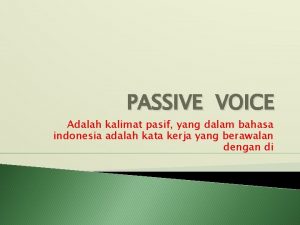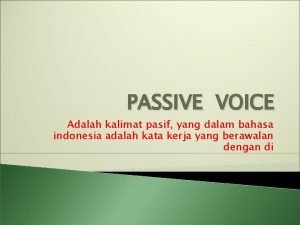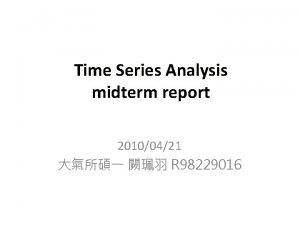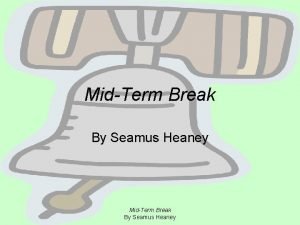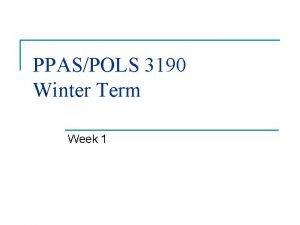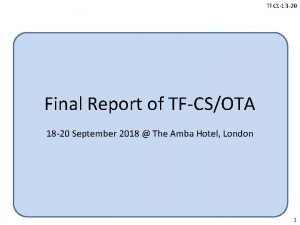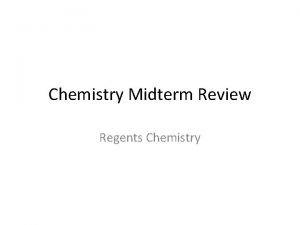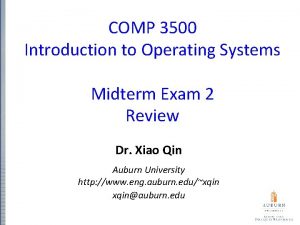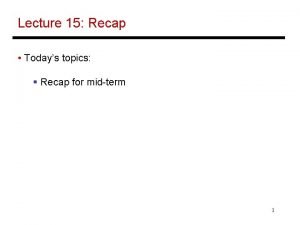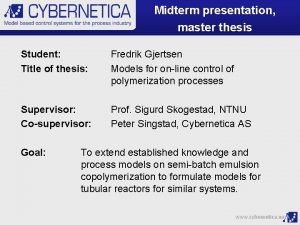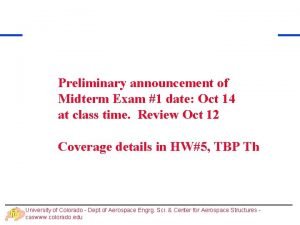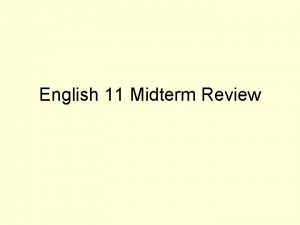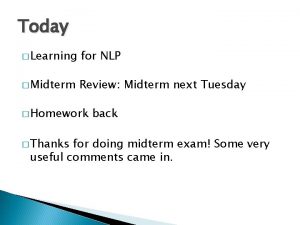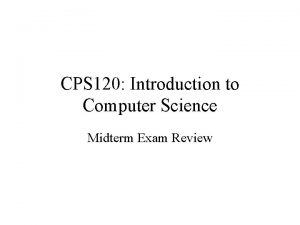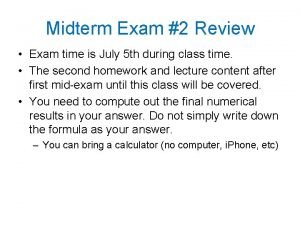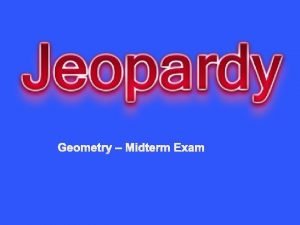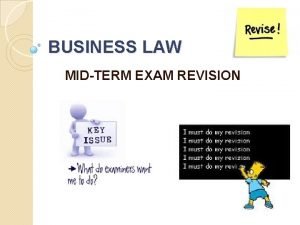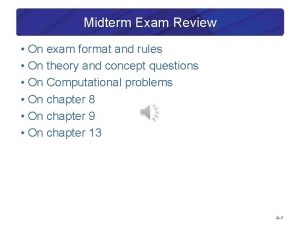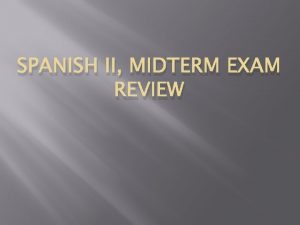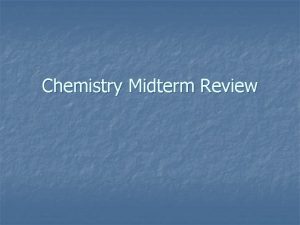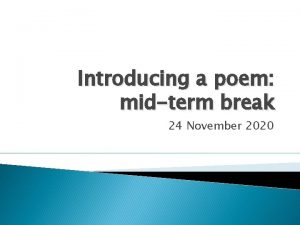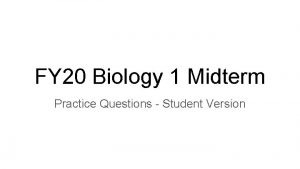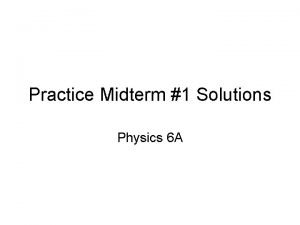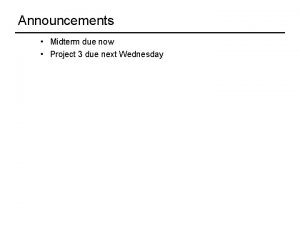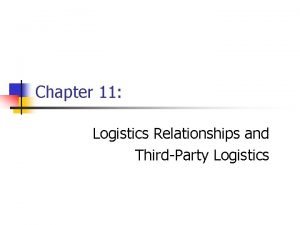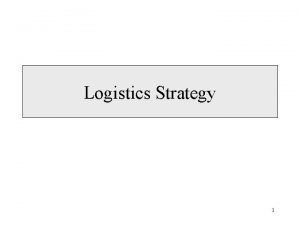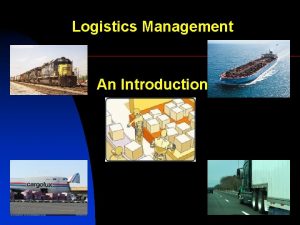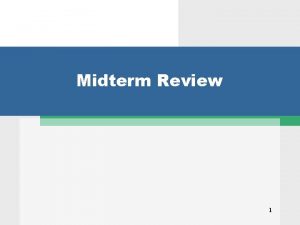Logistics HW due next week Midterm also next








































- Slides: 40

Logistics HW due next week Midterm also next week on Tuesday But the HW is very essential for the midterm Do the HW! It is preparation for the exam Today’s lecture IS in the midterm Some part of Thursday’s lecture will be in the midterm as well • Thursday we will concentrate on ‘how can we compute complexity’ • • •

P, NP Hard, NP Complete • Focus of this lecture = get the definitions across • This will be a part of midterm 2 • Only some small part of the next lecture will be part of the midterm • Next lecture = some complexity examples (non NP complete)

Complexity definitions (seen in 592) • Big-Oh • Big-Theta • Big - Omega

Big Oh (O) f(n)= O(g(n)) iff there exist positive constants c and n 0 such that f(n) ≤ cg(n) for all n ≥ n 0 O-notation to give an upper bound on a function

Omega Notation Big oh provides an asymptotic upper bound on a function. Omega provides an asymptotic lower bound on a function.

Theta Notation Theta notation is used when function f can be bounded both from above and below by the same function g

How bad is exponential complexity • Fibonacci example – the recursive fib cannot even compute fib(50)

The class P • The class P consists of those problems that are solvable in polynomial time. • More specifically, they are problems that can be solved in time O(nk) for some constant k, where n is the size of the input to the problem • The key is that n is the size of input

What is the complexity of primality testing? public static boolean is. Prime(int n){ boolean answer = (n>1)? true: false; for(int i = 2; i*i <= n; ++i) { System. out. printf("%dn", i); if(n%i == 0) { answer = false; break; } } return answer; } This loops until the square root of n So this should be But what is the input size? How many bits does it take to represent the number n? log(n) = k What is Naïve primality testing is exponential!!

Why obsess about primes? • Crypto uses it heavily • Primality testing actually is in P • Proven in 2002 – Uses complicated number theory – AKS primality test

NP • NP is not the same as non-polynomial complexity/running time. NP does not stand for not polynomial. • NP = Non-Deterministic polynomial time • NP means verifiable in polynomial time • Verifiable? – If we are somehow given a ‘certificate’ of a solution we can verify the legitimacy in polynomial time

What happened to automata? • Problem is in NP iff it is decidable by some non deterministic Turing machine in polynomial time. • Remember that the model we have used so far is a deterministic Turing machine • It is provable that a Non Deterministic Turing Machine is equivalent to a Deterministic Turing Machine • Remember NFA to DFA conversion? – Given an NFA with n states how many states does the equivalent DFA have? – Worst case …. 2 n • The deterministic version of a poly time non deterministic Turing machine will run in exponential time (worst case)

NP problems • Graph theory has these fascinating(annoying? ) pairs of problems – Shortest path algorithms? – Longest path is NP complete (we’ll define NP complete later) – Eulerian tours (visit every vertex but cover every edge only once, even degree etc). Solvable in polynomial time! – Hamiltonian tours (visit every vertex, no vertices can be repeated). NP complete

Hamiltonian cycles • Determining whether a directed graph has a Hamiltonian cycle does not have a polynomial time algorithm (yet!) • However if someone was to give you a sequence of vertices, determining whether or not that sequence forms a Hamiltonian cycle can be done in polynomial time • Therefore Hamiltonian cycles are in NP

SAT • A boolean formula is satisfiable if there exists some assignment of the values 0 and 1 to its variables that causes it to evaluate to 1. • CNF – Conjunctive Normal Form. ANDing of clauses of ORs

2 -CNF SAT • Each or operation has two arguments that are either variables or negation of variables • The problem in 2 CNF SAT is to find true/false(0 or 1) assignments to the variables in order to make the entire formula true. ( x y) ( y z) (x z) (z y) • Any of the OR clauses can be converted to implication clauses

2 -SAT is in P • Create the implication graph x y x y z z

Satisfiability via path finding • • If there is a path from And if there is a path from Then FAIL! How to find paths in graphs? – DFS/BFS and modifications thereof

3 CNF SAT (3 SAT) • • Not so easy anymore. Implication graph cannot be constructed No known polytime algorithm Is it NP? – If someone gives you a solution how long does it take to verify it? – Make one pass through the formula and check • This is an NP problem

P is a subset of NP • Since it takes polynomial time to run the program, just run the program and get a solution • But is NP a subset of P? • No one knows if P = NP or not • Solve for a million dollars! – http: //www. claymath. org/millennium-problems – The Poincare conjecture is solved today

What is not in NP? • Undecidable problems – Given a polynomial with integer coefficients, does it have integer roots – Hilbert’s nth problem – Impossible to check for all the integers – Even a non-deterministic TM has to have a finite number of states! – More on decidability later • Tautology – A boolean formula that is true for all possible assignments – Here just one ‘verifier’ will not work. You have to try all possible values

Amusing analogy (thanks to lecture notes at University of Utah) • Students believe that every problem assigned to them is NP-complete in difficulty level, as they have to find the solutions. • Teaching Assistants, on the other hand, find that their job is only as hard as NP, as they only have to verify the student’s answers. • When some students confound the TAs, even verification becomes hard

Reducibility • a problem Q can be reduced to another problem Q’ if any instance of Q can be “easily rephrased” as an instance of Q’, the solution to which provides a solution to the instance of Q • Is a linear equation reducible to a quadratic equation? – Sure! Let coefficient of the square term be 0

NP - hard • What are the hardest problems in NP? • That notation means that L 1 is reducible in polynomial time to L 2. • The less than symbol basically means that the time taken to solve L 1 is no worse that a polynomial factor away from the time taken to solve L 2.

NP-hard • A problem (a language) is said to NP-hard if every problem in NP can be poly time reduced to it.

NP Complete problems/languages • Need to be in NP-Hard If both are satisfied then it is an NP complete problem Reducibility is a transitive relation. If we know a single problem in NP-Complete that helps when we are asked to prove some other problem is NP-Complete Assume problem P is NP Complete All NP problems are reducible to this problem Now given a different problem P’ If we show P reducible to P’ Then by transitivity all NP problems are reducible to P’

What is in NP-Complete • For this course, we will axiomatically state that the following problems are NP-Complete • SAT – Given any boolean formula, is there some assignment of values to the variables so that the formula has a true value • 3 -CNF SAT • Actually any boolean formula can be reduced to 3 -CNF form

An example reduction • CLIQUE problem • A clique in an undirected graph is a subset of vertices such that each pair is connected by an edge • We want to take a problem instance in 3 -CNF SAT and convert it to CLIQUE finding

Reducing 3 CNF SAT to CLIQUE • Given – A boolean formula in 3 CNF SAT • Goal – Produce a graph (in polynomial time) such that • We will construct a graph where satisfying formula with k clauses is equivalent to finding a k vertex clique.

CLIQUE • An instance of a clique problem gives you 2 things as input – Graph – Some positive integer k • Question being asked = do we have a clique of size k in this graph • Why can’t I just go through and pick all possible k-subsets?

Decision problems versus optimization problems • Finding the maximum sized clique is an optimization problem • But we can reduce it to a series of decision problems – Can we find a clique of size 3 (why start at 3? ? ) – Can we find a clique of size 4 – Etc • In general in our study of NP etc, we will focus on decision problems

REDUCE 3 -CNF SAT to CLIQUE For each clause, create a vertex for each literal For the edges Connect vertices if they come from different clauses Even if the vertices come from different clauses, do not connect if it results in incompatibility. No variable should be connected to its not. x 1 ┐x 2 x 2 ┐x 3 x 3 x 1 There are more edges in here. Refer to the CLRS book to get the complete picture

Vertex cover problem • A vertex cover of an undirected graph G=(V, E) is a subset of vertices such that every edge is incident to at least one of the vertices • We’re typically interested in finding the minimum sized vertex cover • To show vertex cover is NP-complete • What problem should we try to reduce to it • It sounds like the ‘reverse’ of CLIQUE • Reduction is done from CLIQUE to vertex cover

G G’ = Complement Of G Clique of size k in G exists iff a vertex cover of size |V| - k exists in G’ where G’ is the complement graph (vertices that had an edge between then in G do not have one in G’ and vice versa)

The original graph has a u, v, x, y CLIQUE. That is a clique of size 4 The complement graph has a vertex cover of size 6 (number of vertices) – 4 (clique size). z, w is one such vertex cover.

The reducibility ‘tree’ • Richard Karp proved 21 problems to be NP complete in a seminal 1971 paper • Not that hard to read actually! • Definitely not hard to read it to the point of knowing what these problems are. • karp's paper

Amusing/tragic NP story • Breaking up over NP

Other NP complete problems • Subset sum • Given a set of positive integers and some target t > 0, do we have a subset that sums up to that target set • Why is the naïve algorithm going to be bad?

Approximation algorithm for Vertex cover C←∅ while E = ∅ pick any {u, v} ∈ E C ← C ∪ {u, v} delete all edges incident to either u or v return C

How bad is that approximation? • Look at the edges returned in that algorithm • Will the optimum vertex cover include at least one end point of the edges returned from approx algorithm?
 X.next = x.next.next
X.next = x.next.next Week by week plans for documenting children's development
Week by week plans for documenting children's development Pimk
Pimk Procedural vs substantive due process
Procedural vs substantive due process Due're/due opposti
Due're/due opposti Due piccole sfere identiche sono sospese a due punti p e o
Due piccole sfere identiche sono sospese a due punti p e o Quadrilateri con due lati opposti paralleli
Quadrilateri con due lati opposti paralleli His landlord asked him to move
His landlord asked him to move Let's plan for next week
Let's plan for next week Kalimat pasif dari i write a letter
Kalimat pasif dari i write a letter Next week we are going to
Next week we are going to Midterm report
Midterm report Seamus heaney midterm break
Seamus heaney midterm break Midterm makeup
Midterm makeup Grva midterm exam
Grva midterm exam English 10 midterm exam answers
English 10 midterm exam answers Regents chemistry midterm
Regents chemistry midterm Operating system midterm exam
Operating system midterm exam Midterm
Midterm Midterm presentation
Midterm presentation Midterm exam announcement
Midterm exam announcement Whap midterm review
Whap midterm review Biology midterm review
Biology midterm review English 11 midterm exam
English 11 midterm exam Ap chemistry midterm exam
Ap chemistry midterm exam Nlp midterm exam
Nlp midterm exam Computer science midterm
Computer science midterm Comp 248 midterm
Comp 248 midterm Midterm paper
Midterm paper Nr 601 week 2 quiz
Nr 601 week 2 quiz Geometry midterm exam
Geometry midterm exam Business law midterm review
Business law midterm review Midterm exam format
Midterm exam format Spanish 2 midterm practice test
Spanish 2 midterm practice test Which substance can be decomposed chemically
Which substance can be decomposed chemically Ipc144 midterm
Ipc144 midterm Mid term break analysis
Mid term break analysis Biology practice midterm
Biology practice midterm Physics practice midterm
Physics practice midterm Eku merit scholarships
Eku merit scholarships Computer science practice midterm
Computer science practice midterm







